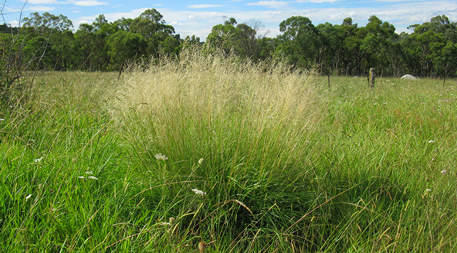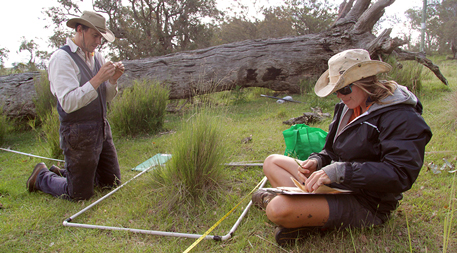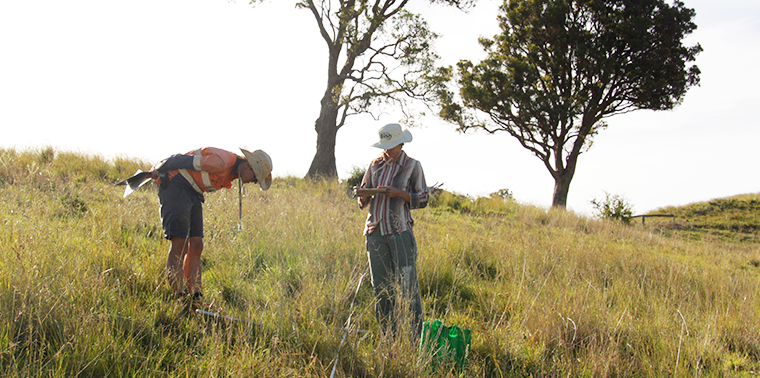September 7, 2017 — Dryland rancher Vivan Mawhinney spends a lot of his time thinking about invasive African lovegrass. As he drives around his property in Australia’s Bega Valley, halfway between Melbourne and Sydney, he’s continually planning how and when he’ll move his Angus cows and Merino ewes around so that he can beat the spread of the densely tufted weed.
Mawhinney’s property covers 600 hectares (1,500 acres) of gently undulating country, 20 kilometers (12 miles) east of a line of blue hills that mark the edge of the Great Dividing Range. About a third is severely infested with the invasive non-native weed, with thick, meter-high tussocks waving fluffy gray heads over most of the paddock. Mawhinney also has smaller infestations over another third of his property.
Lovegrass, once thought to have value as a pasture crop, is hardy and competitive, produces vast quantities of seed that cattle spread via their hair and dung, and it’s well suited to the climate of the valley, in the rain shadow of the Snowy Mountains. But cattle won’t eat it until they’ve chewed every other pasture species to the ground.
“They eat everything else first, so lovegrass gets a distinct advantage,” Mawhinney says. If a farmer’s not careful, it can quickly take over a paddock, making the land all but useless: Cattle can’t survive when they have nothing but lovegrass to eat. Unless it’s fertilized, burned and watered, lovegrass has little nutritional value.

Prolific but unpalatable, nonnative invasive lovegrass is the bane of farmers in southern Australia. Photo courtesy of Harry Rose
The problems with African lovegrass extend beyond its failure as forage. Tussocks can become so big that cattle can’t get between them to search for more palatable grasses. Herding takes longer. Sheep get lost in it. Farmers damage their vehicles going down wombat burrows they can’t see because the lovegrass is so tall.
“If left alone, it’s only a few years and it can actually wipe you out. You end up with no farm at the end,” Mawhinney says.
Lovegrass could also wipe out what little is left of the Bega Valley’s endangered lowland grassy woodlands. With their scattering of eucalyptus trees growing over native pastures composed of tussock grasses, short grasses and herbs, grassy woodlands have been valued historically as a low-cost, drought-resistant source of forage and shelter for cattle and sheep. As agriculture has intensified in the valley, clearing, sowing of non-native pasture species, fertilizer use and intensive grazing have greatly reduced the extent of these native pastures. African lovegrass is rapidly invading what remains. Losing native pastures to lovegrass hurts not only the livelihood of farmers, but the conservation of an endangered ecosystem.
What started as casual conversation among a local plant ecologist, an agricultural officer and a farmers’ representative snowballed into a collaboration.Something needed to be done to help farmers gain control over lovegrass. What started as casual conversation among a local plant ecologist, an agricultural officer and a farmers’ representative snowballed into a collaboration between a team of scientists and an engaged community of farmers that not only led to better lovegrass control, but demonstrated a new way to approach research on invasive species.
Massive Problem
The Bega Valley is famous for its dairy industry — the words “Bega” and “cheese” are inextricably linked in the minds of most Australians — but land in the region is mainly used to graze meat cattle and sheep.
Five years ago, the Far South Coast Landcare Association set up the Bega Valley Farmers’ Network to help the increasing number of dryland farmers in the valley improve the productivity and environmental health of their farms. When the network coordinator Wayne Schaefer first approached farmers to discuss their concerns, African lovegrass emerged as the most important.
“It seemed like such a massive problem, and no one was working on it.” – Josh DorroughSome landholders were managing to keep lovegrass out of their paddocks, while others weren’t. Farmers were divided about how best to control it. Some believed you could manage infestations of lovegrass and still be productive and profitable. Others believed that once lovegrass began to take over a native pasture there was little choice but to convert it to a kikuyu-based pasture that resists lovegrass invasion. Unlike the native tussock grasses, kikuyu, another species introduced from Africa, can compete with lovegrass for soil water and nutrients when it’s grazed
Despite the abundance of farmers’ opinions on lovegrass, there was little evidence that might guide them on the best thing to do. “It seemed like such a massive problem, and no one was working on it,” says ecologist and Bega Valley resident Josh Dorrough, now principal scientist with the Office of Environment and Heritage New South Wales. It was a thought Dorrough (then working as an ecological research consultant) shared with Schaefer and Local Land Services officer Andrew Taylor. Together they gained a small amount of funding to start to bring some science to bear on the issue.
“Landholder-First” Approach
Dorrough began working with farmers’ groups on a research project to better understand how lovegrass affected farmers in the valley, and whether and how they were controlling it. He invited ecologist Jennifer Firn, an associate professor at Queensland University of Technology, to help out. Firn had tested control methods for African lovegrass in southern Queensland and, like Dorrough, saw the value of tapping into the knowledge that farmers had gained from observing lovegrass on their farms over many years, through good seasons and in drought.

To find out what best foils lovegrass, researchers asked local landholders how they controlled the weed, then tested the effectiveness of various approaches. Photo by Max Rosenthal
Dorrough, Firn and research assistant Emma Ladouceur began studying lovegrass in the Bega Valley using what they call a “landholder-first” approach. Dorrough interviewed 15 landholders in the valley about which parts of their farm were being invaded by lovegrass and how they were controlling it. The researchers then tested the landholders’ ideas for controlling the weed in field trials on the same 15 properties. This strategy not only tapped the farmers’ knowledge but also was specifically designed to yield information the farmers would find useful.
Some farmers thought that slashing lovegrass and then putting a large number of cattle per hectare into the paddock was an effective and profitable strategy. But the researchers showed that slashing did not reduce the density of lovegrass. Not only that, but when Dorrough and agricultural economics consultant Jim Crosthwaite analyzed the costs of this approach, they found it was costing farmers more to slash lovegrass than could be earned from grazing cattle in that paddock.
Similarly, many farmers thought an alternative control technique, “roller-wiping” with herbicide, was a waste of time. To roller-wipe a paddock, farmers let their cattle eat down palatable pasture species to less than 15 centimeters (6 inches) in height, then tow a carpeted drum roller covered in herbicide over the taller, uneaten lovegrass. The research showed that roller-wiping was a successful way to reduce even heavy infestations of lovegrass, that it could be cost-effective and that native pastures were likely to recover because the seeds of many native species remained, waiting to germinate, in the soil beneath.
Seriously Practical
The “seriously practical” approach of the researchers impressed Mawhinney, who was one of the farmers involved in the project. He’s now using a roller-wiper on his lighter infestations of lovegrass, and he’s steadily beating it. Word of Mawhinney’s success has spread in the valley: Farmers he doesn’t even know stop him in the street to ask him how he manages his lovegrass, and 60 people attended a recent information session held on his farm.
Such opportunities to share stories of success are important but, Mawhinney says, farmers won’t go to information days where they suspect there’ll be a “total disconnect” between the research that’s being presented and the way farmers actually manage their properties.
The landholder-first approach that Dorrough, Firn and colleagues used for lovegrass reflects an evolving recognition by scientists of the value of engaging with local experts to help understand and solve conservation problems.
Science plays a key role in solving problems but, Knight argues, the idea that science can do so alone is mistaken.“There’s a massive opportunity that gets overlooked, to do science as a social outreach process,” says Andrew Knight, a conservation scientist at Imperial College London. Conservation relies on the values and actions of people, he says. Science plays a key role in solving problems but, Knight argues, the idea that science can do so alone is mistaken. Scientists are rarely the ones implementing their own recommendations, so building relationships with the people that actually manage the land is as important as collecting the ecological data.
Acknowledging that people on the ground matter to the landscape is a shift in thinking that is slowly happening in ecological science, Firn says. The perceptions of those who live on the land “matter more in that community than any scientific paper we can publish, so if we can test the existing ideas — evidence they’re potentially right or evidence they’re potentially not right — then we’re more apt to influence management than just another pamphlet coming to your door.” ![]()
Editor’s note: Viki Cramer produced this feature as a participant in the Ensia Mentor Program. Her mentor for the project was Hillary Rosner.
Ensia shares solutions-focused stories free of charge through our online magazine and partner media. That means audiences around the world have ready access to stories that can — and do — help them shape a better future. If you value our work, please show your support today.
Yes, I'll support Ensia!

Why genetics is HORRIBLE?
because when we make one change nature moves to restore balance and we have no idea how that balance will be restored and what will be its effect on us. Dont expect nature to have mercy on us when we dont on her other creations.
Also, personally as per my research and understanding genetic alterations can happen much faster. anti-biotic resistance in microbes should be enough evidence which ofcourse is being ignored.